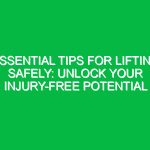Introduction
In the realm of Health, Safety, and Environment (HSE), the concept of Personal Protective Equipment (PPE) is paramount. The levels of Personal Protective Equipment (PPE) refer to the various categories and types of protective gear utilized to shield individuals from workplace Hazards. These Hazards can range from chemical exposure and physical injuries to biological threats, making PPE an essential component of any Safety program. This article delves deep into the various levels of PPE, their significance in HSE, and the Best Practices for their implementation.
Understanding PPE isn’t just about compliance; it’s about fostering a culture of Safety where workers feel empowered and protected. For instance, consider an industrial setting where employees handle hazardous materials. Without proper PPE, the risk of exposure to toxic substances increases dramatically, leading to severe health implications. Therefore, it is crucial to comprehend the levels of PPE available and how they can be effectively employed to mitigate risks.
Understanding the Levels of Personal Protective Equipment (PPE)
The levels of personal protective equipment (PPE) can be categorized into four primary types, each designed to address specific risks and hazards. Below is a detailed exploration of these categories:
1. Level A: Maximum Protection
Level A PPE is the highest level of protection available. It is used when the greatest level of respiratory protection and skin protection is required. This level is essential in scenarios where workers may be exposed to highly toxic chemicals or hazardous materials.
- Components: Level A typically includes a fully encapsulated suit, self-contained breathing apparatus (SCBA), chemical-resistant gloves, and boots.
- Usage Examples: This level is often employed in hazmat situations, such as chemical spills or during the cleanup of toxic waste.
- Real-life Scenario: A response team tackling a chemical leak in an industrial plant would utilize Level A PPE to ensure complete safety from potential airborne toxins.
2. Level B: High Protection
Level B PPE provides a high level of protection against hazardous substances but is not as comprehensive as Level A. This level is used when the type and level of exposure is known and requires a high degree of protection.
- Components: Level B includes a non-encapsulating suit, SCBA, chemical-resistant gloves, and boots.
- Usage Examples: This level is suitable in situations where there is a risk of splashes or exposure to hazardous materials, such as during certain types of Maintenance work.
- Real-life Scenario: Workers handling large quantities of chemicals during a manufacturing process might wear Level B PPE to protect against potential spills.
3. Level C: Moderate Protection
Level C PPE is utilized when the concentration and type of airborne substances are known and the criteria for using air-purifying respirators are met. This level offers a moderate degree of protection.
- Components: Level C typically includes a standard work uniform, coveralls, and an air-purifying respirator.
- Usage Examples: This level is appropriate for environments where the contaminants are known and can be controlled, such as in certain industrial plants.
- Real-life Scenario: A construction site with controlled exposure to dust and chemicals might require workers to wear Level C PPE.
4. Level D: Basic Protection
Level D PPE is the lowest level of protection and is used in environments where there are no specific hazards present. This level is intended for general use.
- Components: Level D may include Safety Glasses, hard hats, gloves, and steel-toed boots.
- Usage Examples: It is utilized in general working conditions where the risk of exposure to hazardous materials is minimal.
- Real-life Scenario: Office workers in a corporate setting who do not handle hazardous materials would typically rely on Level D PPE.
Choosing the Right Level of PPE
Selecting the appropriate level of personal protective equipment (PPE) requires an assessment of the workplace hazards. Employers must conduct comprehensive risk assessments to determine the specific dangers associated with a job.
Risk Assessment Process
1. **Identify Hazards**: Begin by identifying potential hazards in the workplace, which could range from chemical exposure to physical injuries.
2. **Evaluate Risks**: Assess the level of risk associated with each identified hazard, considering the likelihood and severity of potential incidents.
3. **Select Appropriate PPE**: Based on the risk assessment, determine the suitable level of PPE required for the tasks at hand.
For example, in a chemical processing plant, if an assessment reveals potential exposure to corrosive substances, a combination of Level A and B PPE may be required during certain operations.
The Importance of Training and Compliance
Even the highest quality levels of personal protective equipment (PPE) are ineffective without proper training and compliance. Workers must be adequately trained on how to use, maintain, and dispose of PPE. Regular drills and refreshers are essential to ensure that employees remain vigilant and knowledgeable about safety protocols.
Best Practices for PPE Usage
- Regular Training: Conduct ongoing training sessions to keep employees informed about the latest safety practices and equipment.
- Inspection and Maintenance: Implement a routine inspection and maintenance schedule for all PPE to ensure its effectiveness.
- Encourage Reporting: Foster an environment where workers feel comfortable reporting issues with their PPE or safety concerns.
Regulations and Standards Governing PPE
Different countries and regions have established Regulations and standards that govern the use of personal protective equipment (PPE). Understanding these regulations is vital for businesses to maintain compliance and protect their workforce.
OSHA Standards
In the United States, the Occupational Safety and Health Administration (osha) sets forth standards that encompass personal protective equipment. Employers are required to conduct assessments and provide appropriate PPE based on the hazards present in the workplace.
ANSI Standards
The American National Standards Institute (ANSI) also plays a crucial role in establishing standards for various Types of PPE, ensuring that equipment meets specific safety criteria.
Conclusion
The levels of personal protective equipment (PPE) are integral to maintaining health, safety, and environmental standards in various industries. Understanding the categories of PPE, selecting the appropriate level, and ensuring compliance with regulations are vital steps for employers to safeguard their workforce.
PPE is not merely a regulatory requirement; it is a vital component of an effective safety culture. By prioritizing the right PPE and fostering an environment of safety awareness, companies can significantly reduce the risks associated with hazardous work environments. As we move forward, it is essential to remember that the health and safety of workers should always come first, and the right levels of personal protective equipment (PPE) are key to achieving this goal.


